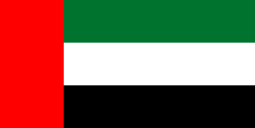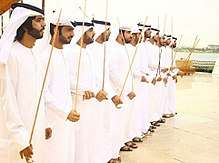Emiratis
The Emiratis or Emirati people (Arabic: الإماراتيون) are the native population and citizens of the United Arab Emirates (UAE). Their largest concentration is in the UAE, where there are 2 million Emiratis.[9]
 | |
| Total population | |
|---|---|
| c. 2 million [1] | |
| Regions with significant populations | |
c. 2,000,000(2015)[2] | |
| 20,990[3] | |
| 12,314[4] | |
| 12,000[5] | |
| 2,885[6] | |
| 1,700 | |
| 1,424[7] | |
| 1,000[8] | |
| Languages | |
| |
| Religion | |
| Sunni Islam, significant minority of Shia Islam. | |
Formerly known as the Trucial States or Trucial Oman, the UAE is made up of seven emirates, each of which had a dominant or ruling family. Abu Dhabi was home to the Bani Yas tribal confederation; Dubai settled in 1833 by an offshoot of the Bani Yas, the Al Bu Falasah; Sharjah and Ras Al Khaimah to the Al Qasimi or Qawasim; Ajman to the Al Na'im and Fujeirah to the Sharqiyin.
History

The United Arab Emirates is a union of seven emirates in which their history is entwined with various empires, such as those of Portugal and the United Kingdom. The Romans also exerted influence in the Persian Gulf. Envoys from the Islamic prophet Muhammad saw the islands convert to Islam around 630 C.E.
Later in the 16th century the Portuguese would battle the then dominant force in the Persian Gulf, the Safavid dynasty, for control of the region. During the 17th century, the Ottomans took control of the islands and UAE was known as the "Pirate Coast." By the 19th century, the British Empire had taken complete control of the land then called the Trucial States.[10] Oil was discovered in 1959. The Trucial States were under the control of the British Empire until 1971. Consequently, with weakening British control, the Trucial States became the UAE in 1971 with Ras al-Khaimah joining in 1972.[10]
The term Emirati comes from the plural of the Arabic word emirate (Arabic: إمارة), with adding the suffix -i. Each emirate is ruled by a Sheikh. The Bani Yas tribe forms the basis of many clans within the UAE. Sub-clans of the Bani Yas include[11]
- Al Bu Falah (Abu Dhabi)
- Al Bu Falasah (Dubai)
The term "Emirati" also refers to Arabs with origins in the UAE. Many modern Emirati names are derived from these tribal names or offshoots of these tribes, for instance Mazroui (from Mazari), Nuaimi (from Naim) and Al Sharqi (from Sharqiyin).[12]
Emiratism
_(cropped).jpg)
Emiratism (or Emirianism) is the advocacy of Emirati national identity. The government introduced a scheme in order to promote Emiratism by giving them jobs in the private sector and encouraging them to join private sector establishments in the workplace.[13] This is accomplished through several means, such as increasing the visibility of Emirati culture, by preserving Emirati cultural identity, and by preferentially employing Emiratis in the workforce. The latter policy is referred to as Emiratisation by the government.[14]
Lexicology
The word Emirati is a word derived from a combination of the word emir, which means "prince," and the Greek suffix -ate. It gradually came to mean the United Arab Emirates. The demonym Emirian has a similar root from except with the suffix -ian being added to emir. Rarer Emirian demonyms and adjectives include Emiri and Emiratian, both of which are unofficial and informal alternatives.[15] However, due to strong tribal allegiances, many Emiratis also self-identify by their tribal affiliations.[16] Historically, Emiratis were called Trucial Coasters[17] or Trucials.[18] Emirians from ancient history are called Maganites.[19]
National symbols
Falcon training is one of the UAE's national symbols. These birds can be seen on the coat of arms of the United Arab Emirates. They were traditionally used for hunting, and trained by the Bedouin tribes. Most Emiratis view Sheikh Zayed as an essential component of Emirati nationalism,[20] Emiratis are proud of their nation's global name associated with tourist prospects, prefer interactions with fellow nationals, most are computer literate and adult Emiratis past born in the 21st century are more likely to be bilingual[21][22] There are many landmarks and sculptures in the country of teapots, water jugs and coffeemakers to symbolize the hospitality of the Emirati people. Due to the pearl-diving history of the Emirates, nautical sailing and other activities at sea are sometimes emphasized.[23] Due to its prominence throughout Emirati history in cultivation, datefruits play an important role in Emirati life. Another national symbol is the Arabic coffee pot with the elongated thin spout called a Dallah; a sign of Emirati generosity.
Demographics
The population of the UAE as of 2019 was 9.7 million[24] with a minority being Emiratis. UAE nationals make up 1 million.[1] Statistics for UAE nationals in 2018 as it follows:
| Emirate | Male | Female | Total | ref | |
|---|---|---|---|---|---|
| Abu Dhabi | 204,108 | 200,438 | 404,546 | ||
| Ajman | 21,600 | 20,586 | 42,186 | ||
| Dubai | 127,641 | 126,959 | 254,600 | [25] | |
| Fujairah | 32,486 | 32,374 | 64,860 | ||
| Ras Al Khaimah | 49,181 | 48,348 | 97,529 | ||
| Sharjah | 78,818 | 74,547 | 153,365 | ||
| Umm Al Quwain | 8,671 | 8,811 | 17,482 | ||
| United Arab Emirates | 522,505 | 512,063 | 1,034,568 | ||
Non-emirati origin populations form the vast majority of the UAE (88.52%) and is composed of expatriates, with the largest groups hailing from South Asian countries such as India (2.62 million), Pakistan (1.21 million) and Bangladesh (706,000). There are also nationals of other GCC and Arab countries who live in the UAE. Members of other Asian communities, including Iran (454,000), the Philippines (530,000).[26]
Language
Emirati Arabic is a variety of Arabic used in the UAE. Emiratis speak Emirati Arabic, Achomi, Persian, Balochi, Shihhi Arabic, Swahili, Mehri and Luwati.
Culture
Emirati culture is based on Arab culture and has been influenced by the religion Islam. Arabian influence on Emirati culture is noticeably visible in traditional Emirati architecture. Ever since the 20th century, the country has become more cosmopolitan and aspects of Western culture are very visible here.
Values
The influence of Islamic culture on Emirati architecture, music, attire, cuisine and lifestyle are very prominent as well. Five times every day, Muslims are called to the prayer from the minarets of mosques which are scattered around the country.[27]
Some oriental educationists and cultural academics have stated that luxuriousness and some extravagance is a feature of the Emirati culture.[28]
Music and dance

Emirati music varies to each area although most are on folklore's, some cultural dances are the horbya which well known all over the United Arab Emirates, The Ayala which is well known in Abu Dhabi and Dubai. Other music is shalat which does not involve any type of instruments.
Religion
Islam is the largest and the official state religion of the UAE and the government follows a policy of tolerating existence of other religions, through the Ministry of Tolerance.
There are approximately 31 churches throughout the country, one Hindu temple in the region of Bur Dubai, 2 Sikh Gurudwaras, with the biggest one located in Jebel Ali district of Dubai and a Buddhist temple in the Al Garhoud of Dubai.[29] Emiratis are largely Muslims, approximately 85% of whom are Sunni and the remaining 15% are Shia.[30]
The government gives freedom to people to choose their significant others.[31]
Diaspora
Emirati ancestry, the result of emigration, also exist in other parts of the world, most notably in the Arabian Peninsula, Europe and North America. Population estimates are seen to have a very small diaspora, mainly because the UAE provides them with more than adequate welfare benefits, removing the need to live and work in other developed countries.[32]
See also
References
- "UAE population and statistical trends". Retrieved 25 December 2018.
- Snoj, Jure (12 April 2015). "UAE´s population - by nationality". bq Magazine. Archived from the original on 21 March 2017. Retrieved 28 February 2017.
- Canada, Government of Canada, Statistics (25 October 2017). "Immigration and Ethnocultural Diversity Highlight Tables – Immigrant population by place of birth, period of immigration, 2016 counts, both sexes, age (total), Canada, 2016 Census – 25% Sample data". 12.statcan.gc.ca. Retrieved 27 May 2018.
- "Trends in International Migrant Stock: Migrants by Destination and Origin (United Nations database, POP/DB/MIG/Stock/Rev.2015)" (XLS). United Nations, Department of Economic and Social Affairs. 2015. Retrieved 2 January 2017.
- "Trends in International Migrant Stock: Migrants by Destination and Origin (United Nations database, POP/DB/MIG/Stock/Rev.2015)" (XLS). United Nations, Department of Economic and Social Affairs. 2015. Retrieved 2 January 2017.
- "Anzahl der Ausländer in Deutschland nach Herkunftsland (Stand: 31. Dezember 2014)". statista. Archived from the original on 7 July 2015. Retrieved 22 July 2015.
- http://pxnet2.stat.fi/PXWeb/pxweb/fi/StatFin/StatFin__vrm__muutl/statfin_muutl_pxt_11a9.px/table/tableViewLayout2/?rxid=726cd24d-d0f1-416a-8eec-7ce9b82fd5a4
- "Population at the first day of the quarter by municipality, sex, age, marital status, ancestry, country of origin and citizenship". Statistics Denmark. Archived from the original on 9 February 2015. Retrieved 26 September 2014.
- "UAE population and statistical trends". Retrieved 25 December 2018.
- MobileReference (2010). Travel Dubai, United Arab Emirates: Illustrated Guide, Phrasebook and Maps. Google eBooks. ISBN 9781607788362. Archived from the original on 23 January 2016.
- : The Government and Politics of the Middle East and North Africa Archived 5 November 2015 at the Wayback Machine. Long, Reich.
- Heard-Bey, Frauke (1990). From Trucial States to United Arab Emirates. London: Longman. pp. 27–80. ISBN 0582277280.
- Neil Patric (8 November 2008). "Nationalism and Internal Tensions in the UAE". The Institute of Energy Economics, Japan. Archived from the original on 4 July 2015. Retrieved 3 July 2015.
- Kalir, Sur, Barak, Malini (2012). Transnational Flows and Permissive Politie.
- Douglas, Allen (1994). Arab comic strips. p. 150.
- "In the UAE the only tribe is the Emirati". gulfnews.com. Retrieved 25 December 2018.
- Winder, Bayly (1965). Saudi Arabia in the Nineteenth Century. p. 33.
- Unexceptional: America's Empire in the Persian Gulf, 1941–2007, Marc J. O'Reilly, page 66
- Winder, Bayly (1965). Saudi Arabia in the Nineteenth Century. p. 33.
- Cross, Jay (2011). Informal Learning.
- "Emiratis Want Crackdown On Tourists' Skimpy Dresses". Huffington Post. 6 July 2012. Archived from the original on 7 October 2014.
- Mahdi, Ali (2003). Teen Life in the Middle East. p. 239.
- Bruijn, Liza (2010). Doing the deal, globally. p. 140.
- UN projection
- "Number of Population Estimated by Nationality- Emirate of Dubai" (PDF). Retrieved 2 December 2018.
- UNITED ARAB EMIRATES POPULATION STATISTICS (2018)
- "UAE Culture". Uae.gov.ae. 1 June 2000. Archived from the original on 19 July 2009. Retrieved 15 July 2009.
- Butler, Stuart (2007). Oman, UAE & Arabian Peninsula. p. 422.
- Advanced Digital Technology www.adtworld.com (5 April 2008). "Gulfnews: Churches and temples in the UAE". Archive.gulfnews.com. Archived from the original on 31 July 2009. Retrieved 15 July 2009.
- There are also 2 Sikh Gurudwaras with the biggest one in Jebel Ali and a Buddhist temple in Al Garhoud.United Arab Emirates Religion
- United Arab Emirates International Religious Freedom Report, Bureau of Democracy, Human Rights, and Labor (2009)
- "Archived copy". Archived from the original on 26 April 2016. Retrieved 26 April 2016.CS1 maint: archived copy as title (link)
| Look up Emirian in Wiktionary, the free dictionary. |
| Look up Trucial in Wiktionary, the free dictionary. |
| Look up Trucial Coaster in Wiktionary, the free dictionary. |